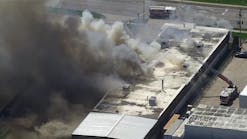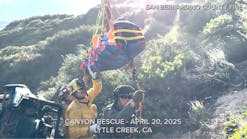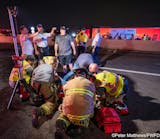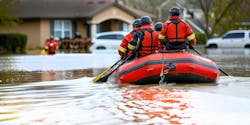Although there has been recent development of new equipment that has made a significant improvement in how building collapse rescue operations are resolved, the strategy and tactics of the collapse rescue operational plan that we use today can be traced directly back to the time of World War II.
As England sustained heavy damage during many bombing raids, and scores of people were trapped in collapsed buildings, a five step plan was developed by the British government's Civil Defense Department, fire service and military to organize the confusion at a collapse operation. Based on the extensive experience gained by rescue personnel in England, this same plan was adopted by the U.S. Department of Civil Defense during World War II. This five-step plan is essentially the same plan that is taught today in many courses, although the first two components have been combined, resulting in a four-step sequence.
COLLAPSE RESCUE OPERATIONAL PLAN
Survey/assessment and surface search Void search Selected debris removal General debris removalBy following the above plan and breaking the incident down into four main stages, the collapse rescue operation can progress from one step to another in a systematic manner.
1. SURVEY/ASSESSMENT & SURFACE SEARCH
The most important step in this operational plan is the initial size-up performed in the survey/assessment phase. Actions taken early on usually set the tone for the entire operation. A complete safety assessment of the entire area should be undertaken by the first-arriving unit(s). This survey should include a six-sided approach to the total area involved (front, rear, sides, top, and bottom of the collapsed structure) and should specifically include a survey for victims, status of utilities, visible fire, extent of collapse and obvious dangers. The remaining building should be surveyed to see how it can be shored and stabilized. At this time, the remaining upper sections of the building should be checked for hanging structural hazards. A size-up and check of the basement for structural conditions and stability should also occur during this stage. Potential for secondary collapse should now be carefully evaluated.
At this point, information regarding the building's use, the number of occupants, and the number of victims trapped and their probable location should be ascertained. Concurrently, as the safety assessment priorities listed above are being evaluated, the incident command system should automatically be activated.
Similar to a hazardous materials incident, the area should be broken down into three distinct zones: the "hot" zone (the collapsed building itself along with adjoining exposures and any secondary collapse potential sections), the "warm" zone (where specialized equipment is staged and a cutting station is set up for shoring operations), and a "cold" zone (where the command post and a staging area for remaining personnel and apparatus are set up).
It is imperative that all utility services are shut down as soon as possible to minimize the dangers to buried victims and also to firefighters operating at the collapse site. Utility companies should also be notified to respond via the radio dispatcher automatically for consultation and assistance, even if a specific utility service is not involved at this point.
Standard operating procedure for the first-due engine company is to obtain a hydrant position and immediately stretch a hoseline. The second-, third- and fourth-due engine companies should obtain a hydrant position and, as conditions dictate, will stretch additional hoselines.
As in other special operations, it is extremely important to have an outside resource list in place for specialized equipment and personnel that are not available from within the fire department. Strong consideration to utilize part (or all) of the assets on the list should begin early in the operation (during the survey/assessment phase). The following speciality areas should be included on the list: structural engineers, architects, practical shoring engineers, utility company contacts (for emergency operations and also for readily available heavy construction equipment), demolition contractors (with an itemized list of heavy equipment available), search dogs, sources for immediate delivery of lumber for shoring, technical advisors (for example, personnel from the Federal Emergency Management Agency's Urban Search And Rescue Task Forces), and other municipal departments (such as the highway department for heavy equipment).
Signed contracts and agreements between the fire department/city government and these private contractors should be in place (and periodically updated) so that there is no delay in providing emergency services (due to misunderstanding or billing questions at the collapse site).
This is the stage of the operation where needs are projected for the entire duration. Due to the extended "reflex time" required to get certain resources on the site, it is standard practice to request the response of certain outside resources immediately upon assessment, even though these resources will not be used until the third or fourth stages of the operational plan.
As the survey/assessment phase switches into the "action" phases, the search and removal of victims on the surface (and also those victims who can be easily extricated from minor debris entanglement near the surface) of the collapse site is now accomplished. According to statistics, half of the people rescued from collapsed buildings are found during this stage.
2. VOID SEARCH
After the first stage is completed, all voids (spaces and crevices throughout the rubble) should be identified and searched. About 25% of victims are found during this phase. There are four major types of collapse patterns.
- Pancake collapse void. Floors fall as a unit and fall in a stacking effect on top of each other. Victims are usually found between floors or in voids created by furniture or machinery.
- V-shaped collapse void. The floor breaks near the center and falls to the floor below while still attached to the exterior walls, forming a "V."
- Supported lean-to collapse void. The floor fails at one end and stays anchored at the other end.
- Unsupported lean-to collapse void. Sometimes called lean-to cantilever collapse void, this is similar to a supported lean-to collapse, with the following important exception: the failed end hangs with no solid support, creating the most unstable and dangerous type of collapse. The potential for secondary collapse is significant; the unsupported floor area must carefully be secured and stabilized.
At this point, a determination should be made as to whether the operation will proceed as a rescue operation or a body recovery. If it is determined to be a rescue, then the time factor becomes critical, and rescuers could expect to be exposed to a certain amount of calculated risk. If it is a body recovery, time is no longer a controlling factor, and risk to firefighters is not acceptable. "Rescue vs. recovery" is one of the most critical decisions the incident commander has to make.
The type of building construction involved will have a significant impact on this decision due to the fact that the type of building materials involved will dictate the types of tools required, and the specific tactics for the extrication of victims. Most importantly, it will dictate the time required to complete the task.
Although monitoring for secondary collapse must occur throughout all four stages of the operational plan, it is mandatory that it occurs during the void search phase. This is accomplished by assigning at least one member to closely monitor the area(s) involved. This position is usually augmented by another member who will use a builder's transit to detect any movement in the portion of the building (or exposures) still standing. Any visual changes are then immediately communicated to the incident commander, and the operational plan is adjusted accordingly.
Locating Buried Victims
One of the most challenging aspects of collapse operations is locating buried victims. This is critical because efforts spent in shoring and breaching operations in the wrong area will waste valuable time and resources and unnecessarily fatigue the rescuers. Four main methods are employed.
Physical search is the most dangerous for rescuers, because it involves deploying personnel over and around a collapse and actually committing rescuers into unstable void spaces to physically search for victims. One method employed by firefighters conducting physical searches in void spaces is termed "Round-the-Clock." After complete silence is obtained (all radios turned off, etc.), members try to establish contact with any victims and determine a "fix" as to their location. Once a "fix" has been made, an additional "fix" is attempted from another angle to minimize error. Once communication has been established with a victim, one member is assigned to maintain this vital link.
Electronic search is usually employed in the form of acoustical listening devices. These instruments are designed to pick up the slightest sound(s) of a buried victim. One style of this piece of equipment has two leads which can be stretched in different directions and, along with a metering device, can pinpoint the location of a victim buried under the rubble of a collapsed building. This is a slower type of search, but it is not nearly as risky to rescuers.
Canine search involves dogs and their handlers specifically trained in building collapse operations. Canine search teams should be available from the outside resource list. This type of search covers the largest area in the quickest amount of time, and was used with great success in the Oklahoma City Federal Building bombing and during numerous operations following earthquakes in California.
Fiber-optic search is the most sophisticated and the most accurate type of search method. It is used in conjunction with concrete or masonry drills that bore narrow inspection holes. The flexible scope of the camera is then inserted into the holes, and a television-like picture is then transmitted back to the operator. This verification leaves no guesswork as far as the location of the victim and the degree of entrapment.
It is standard practice to blend all of the four search capabilities into one logical plan. The area in question should be sectored, and general features of the structure should be sketched to use as a reference. Buried victim location should be confirmed by two separate search methods whenever possible.
A systematic search of all collapse voids should occur. Obviously, natural voids (voids already created by the collapse) should be searched prior to trenching and tunneling. Natural voids will be the fastest and easiest to explore, and most surviving victims will be found there. During the void search phase (after natural voids have been identified and searched), trenching and tunneling may be required to reach buried victims. In this operation, void spaces are created by rescuers. This operation is extremely dangerous because of the potential for rescuers to cause a secondary collapse.
Once the location of buried victims is confirmed, a transition is made from search to rescue operations. Most collapse rescue operations benefit from a "two-sided" approach. This two-sided approach was successfully used at a recent building collapse operation in Philadelphia where seven firefighters were buried. One approach was from the top down and one was from the Exposure D (or Exposure 4) side. This resulted in firefighters being extricated through the top and the side; both approaches taken by rescuers led to the same voids involved. If the attempt in the first area takes longer than expected (or no longer becomes viable due to unforeseen obstacles encountered), the second access route is already identified, and work in that area is already underway, saving valuable time.
Shoring Operations
While some shoring activity will most likely have occurred as the search is being conducted, shoring operations will increase in complexity as breaching and tunneling is done to reach the victims and extricate them. Collapse rescue shoring is defined as the temporary support of only that part of a damaged or partly collapsed structure that is required for conducting operations at reduced risk.
Weights of common building materials have a definite impact on the type of shoring system constructed. The difference between wood debris (35 pounds per cubic foot) and steel debris (almost 500 pounds per cubic foot) is substantial, and shoring systems have to be constructed in order to support the total load encountered. A quick rule of thumb used to calculate the weight of concrete or masonry rubble is 10 pounds per square foot (per inch of thickness).
Four major types of shoring materials or systems are utilized by the fire service: wood, mechanical, pneumatic and hydraulic. Similar to the six-sided approach to the entire building that is taken in the survey/assessment phase, each individual void space where extrication operations take place must be evaluated from the same perspective (top, bottom, front, rear, and both sides). Areas that are of questionable stability must be shored and stabilized.
3. SELECTED DEBRIS REMOVAL
Work in this stage includes the removal of debris according to a pre-determined plan based upon how the floor has fallen, where the victims may have been at the time of collapse, the type of collapse, etc. Many times, this debris removal requires the use of rigging expertise in conjunction with heavy construction equipment such as a backhoe or hydraulic crane.
4. GENERAL DEBRIS REMOVAL
This final phase occurs after all other methods have been employed, persons are still missing and/or their location is still unknown. This task must be accomplished in a systematic, rapid manner. All debris is removed (usually by heavy construction equipment) and taken to a secure area near the collapse site where it is carefully sorted through for bodies or body parts.
Operational Guidelines
A building collapse rescue operation is one of the most demanding incidents a fire department can encounter. Following are some general guidelines for operations at collapse sites:
- It is safer to reach entrapped victims from above, although consideration may be given to enter a collapsed area from below (for example: where a roof or floor may have fallen, a basement sidewalk entrance door may allow access to a cellar from which the rescuer can enter the building from the outside, then ascend the interior stairs to the specific collapse area).
- Breaching and shoring (similar to tunneling and trenching) may be required to reach some victims.
- The cutting of holes in floors and using a "shaft approach" is much safer than the breaching of walls.
- Do not attempt to return structural components to their original configuration. Stabilize and shore the structure according to the way you find it.
- Wood (timber) shores should be kept as short as possible.
- Air shore, hydraulic or mechanical systems can be used in conjunction with or in place of wood (timber) shores.
- Once shoring is in place, it should never be removed.
- A safety officer should be designated and assigned for the entire duration of the operation. He should have the authority to stop the operation any time he deems necessary.
- Consideration should be given to gain access to the basement of a collapsed structure by breaching the party wall of an adjoining building in the same row.
- Limit the number of firefighters working in the danger zone to the bare minimum required.
- Utilize a search rope in tunneling/trenching operations. If a secondary collapse occurs, the rope identifies the path to the trapped rescue personnel.
- Meter readings for oxygen and combustible gas must be taken during tunneling and void space operations. Confined space operational procedures must be adhered to as required.
- Consideration should be given to utilize supplied air breathing systems (air source, air extension hose, and face masks) in a tunnel or void space where there is a danger of smoke, oxygen depletion, or exhaust fumes (and SCBA duration will be too limited or SCBA will be too bulky in narrow opening of void space).
- A personnel accountability system should be utilized for firefighters operating in the "hot zone."
- Hoseline(s) should be stretched into or in the vicinity of each major void space operation, even if fire is not evident upon entry into the void space. Conditions can rapidly change. Fire could be burning undetected underneath the area where you are working, and this precaution will save valuable time if the conditions change.
- Every collapse incident should be reviewed/analyzed in a post-collapse critique.
Fred Endrikat, a Firehouse® contributing editor, is a 23-year veteran of the Philadelphia Fire Department, currently assigned as lieutenant of Rescue Company 1. Additionally, he serves as a Task Force Leader for Pennsylvania Urban Search and Rescue Task Force 1, one of the 27 USAR Task Forces commissioned by the Federal Emergency management Agency (FEMA).










